CADILLAC SRX 2008 1.G User Guide
Manufacturer: CADILLAC, Model Year: 2008, Model line: SRX, Model: CADILLAC SRX 2008 1.GPages: 448, PDF Size: 5.61 MB
Page 11 of 448
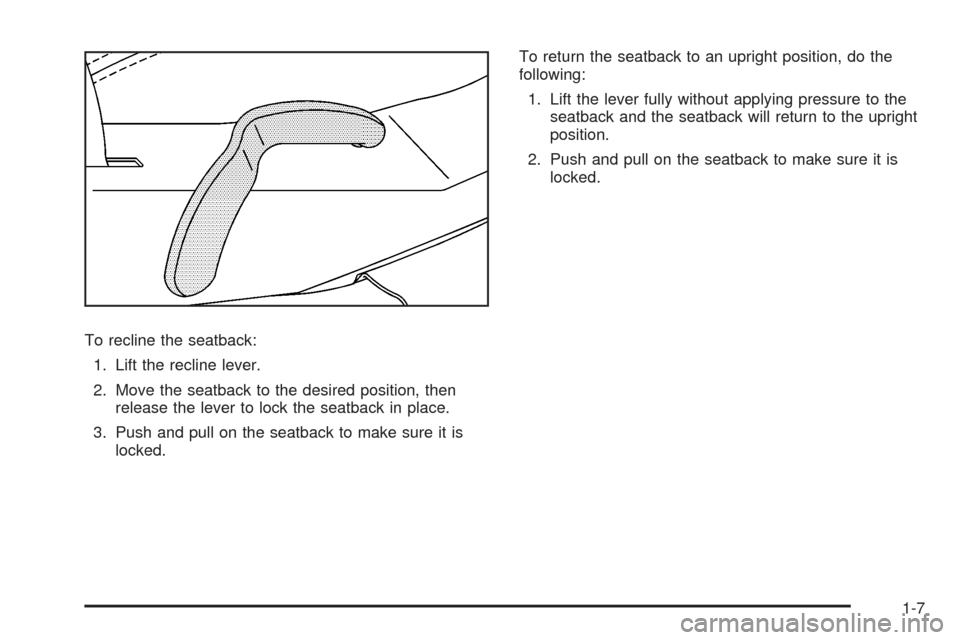
To recline the seatback:
1. Lift the recline lever.
2. Move the seatback to the desired position, then
release the lever to lock the seatback in place.
3. Push and pull on the seatback to make sure it is
locked.To return the seatback to an upright position, do the
following:
1. Lift the lever fully without applying pressure to the
seatback and the seatback will return to the upright
position.
2. Push and pull on the seatback to make sure it is
locked.
1-7
Page 12 of 448

Power Reclining Seatbacks
If your seats have power reclining seatbacks, use the
vertical power seat control located on the outboard side
of each seat.
To recline the seatback, press the control toward
the rear of the vehicle.
To raise the seatback, press the control toward the
front of the vehicle.
1-8
Page 13 of 448

{CAUTION:
Sitting in a reclined position when your vehicle
is in motion can be dangerous. Even if you
buckle up, your safety belts cannot do their
job when you are reclined like this.
The shoulder belt cannot do its job. In a crash,
you could go into it, receiving neck or other
injuries.
The lap belt cannot do its job either. In a crash
the belt could go up over your abdomen. The
belt forces would be there, not at your pelvic
bones. This could cause serious internal
injuries.
For proper protection when the vehicle is in
motion, have the seatback upright. Then sit
well back in the seat and wear your safety belt
properly.
Do not have a seatback reclined if your vehicle is
moving.
Head Restraints
Adjust the head restraint so that the top of the restraint is
at the same height as the top of the occupant’s head.
This position reduces the chance of a neck injury in a
crash.
1-9
Page 14 of 448
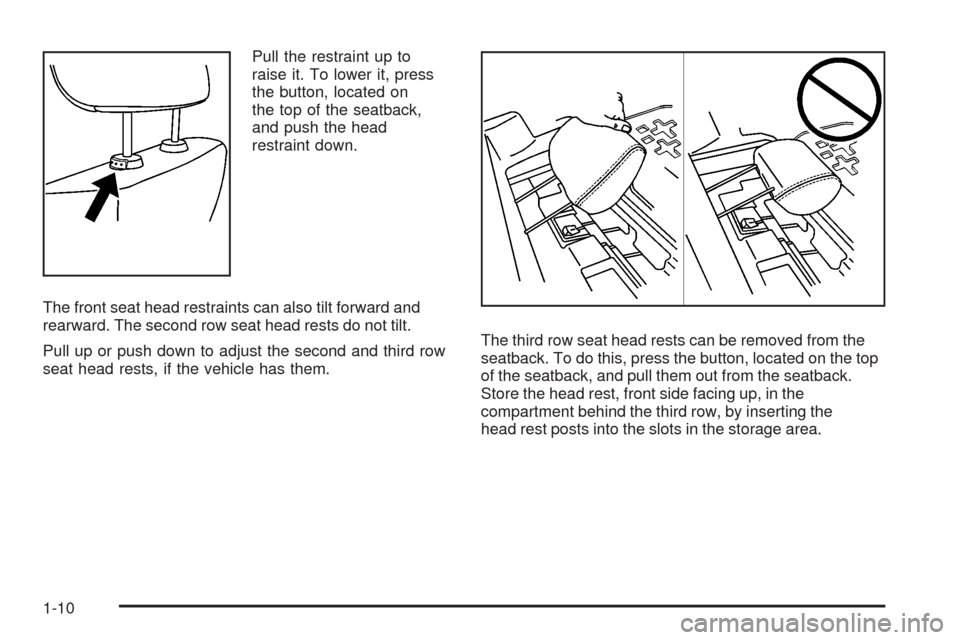
Pull the restraint up to
raise it. To lower it, press
the button, located on
the top of the seatback,
and push the head
restraint down.
The front seat head restraints can also tilt forward and
rearward. The second row seat head rests do not tilt.
Pull up or push down to adjust the second and third row
seat head rests, if the vehicle has them.The third row seat head rests can be removed from the
seatback. To do this, press the button, located on the top
of the seatback, and pull them out from the seatback.
Store the head rest, front side facing up, in the
compartment behind the third row, by inserting the
head rest posts into the slots in the storage area.
1-10
Page 15 of 448
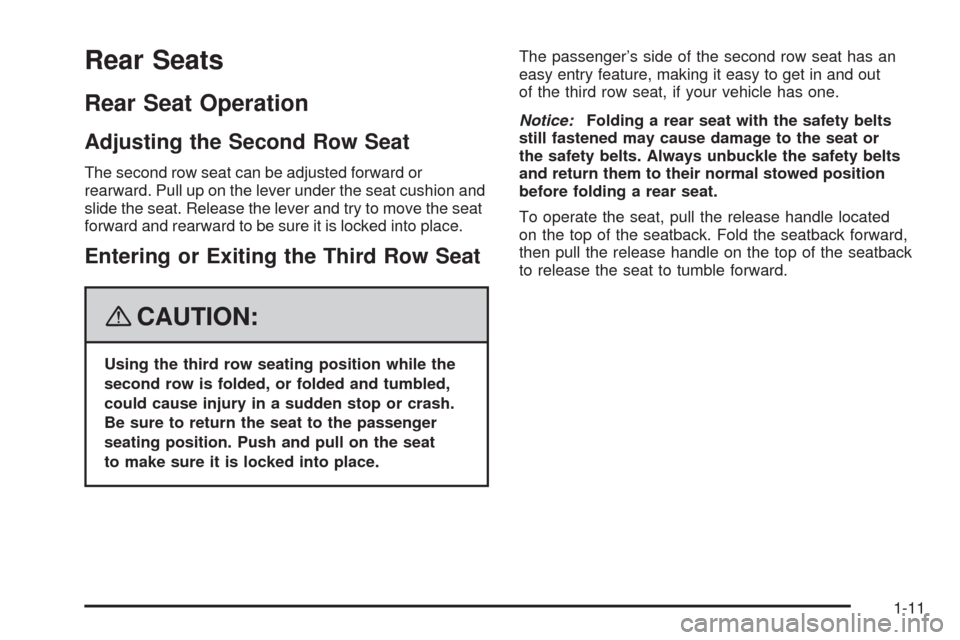
Rear Seats
Rear Seat Operation
Adjusting the Second Row Seat
The second row seat can be adjusted forward or
rearward. Pull up on the lever under the seat cushion and
slide the seat. Release the lever and try to move the seat
forward and rearward to be sure it is locked into place.
Entering or Exiting the Third Row Seat
{CAUTION:
Using the third row seating position while the
second row is folded, or folded and tumbled,
could cause injury in a sudden stop or crash.
Be sure to return the seat to the passenger
seating position. Push and pull on the seat
to make sure it is locked into place.The passenger’s side of the second row seat has an
easy entry feature, making it easy to get in and out
of the third row seat, if your vehicle has one.
Notice:Folding a rear seat with the safety belts
still fastened may cause damage to the seat or
the safety belts. Always unbuckle the safety belts
and return them to their normal stowed position
before folding a rear seat.
To operate the seat, pull the release handle located
on the top of the seatback. Fold the seatback forward,
then pull the release handle on the top of the seatback
to release the seat to tumble forward.
1-11
Page 16 of 448
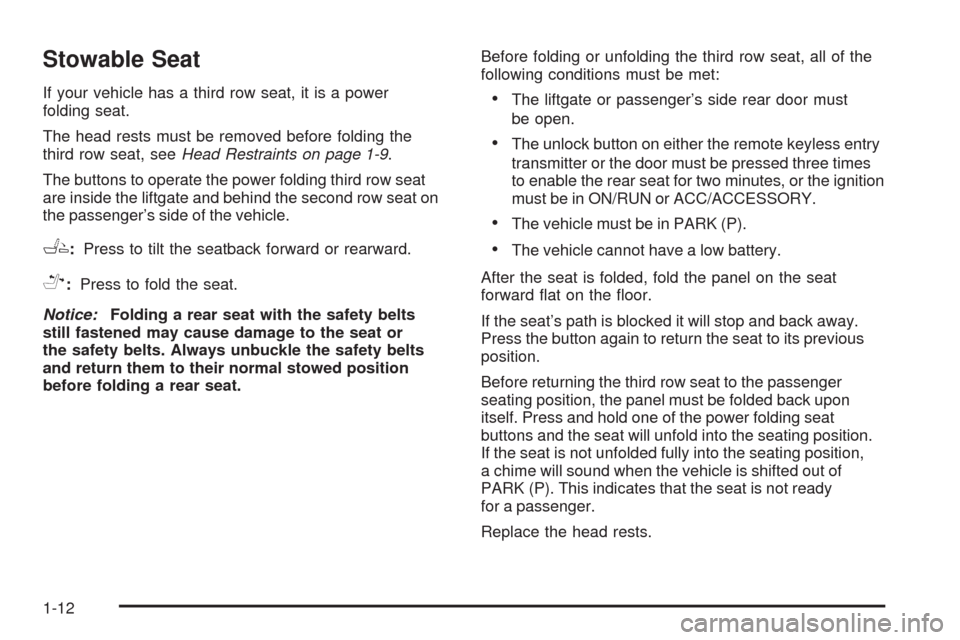
Stowable Seat
If your vehicle has a third row seat, it is a power
folding seat.
The head rests must be removed before folding the
third row seat, seeHead Restraints on page 1-9.
The buttons to operate the power folding third row seat
are inside the liftgate and behind the second row seat on
the passenger’s side of the vehicle.
e:Press to tilt the seatback forward or rearward.
f:Press to fold the seat.
Notice:Folding a rear seat with the safety belts
still fastened may cause damage to the seat or
the safety belts. Always unbuckle the safety belts
and return them to their normal stowed position
before folding a rear seat.Before folding or unfolding the third row seat, all of the
following conditions must be met:
The liftgate or passenger’s side rear door must
be open.
The unlock button on either the remote keyless entry
transmitter or the door must be pressed three times
to enable the rear seat for two minutes, or the ignition
must be in ON/RUN or ACC/ACCESSORY.
The vehicle must be in PARK (P).
The vehicle cannot have a low battery.
After the seat is folded, fold the panel on the seat
forward �at on the �oor.
If the seat’s path is blocked it will stop and back away.
Press the button again to return the seat to its previous
position.
Before returning the third row seat to the passenger
seating position, the panel must be folded back upon
itself. Press and hold one of the power folding seat
buttons and the seat will unfold into the seating position.
If the seat is not unfolded fully into the seating position,
a chime will sound when the vehicle is shifted out of
PARK (P). This indicates that the seat is not ready
for a passenger.
Replace the head rests.
1-12
Page 17 of 448
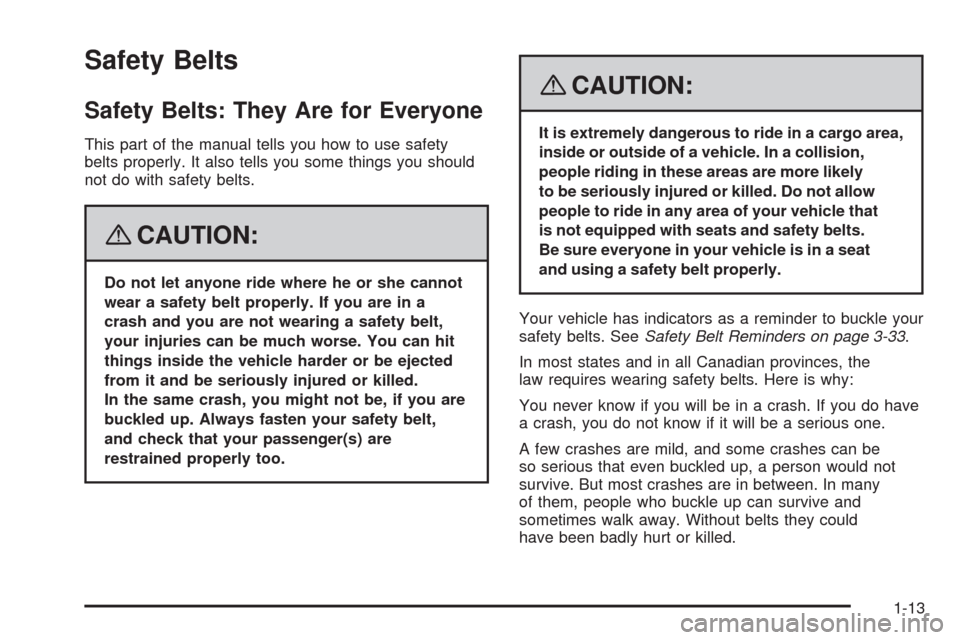
Safety Belts
Safety Belts: They Are for Everyone
This part of the manual tells you how to use safety
belts properly. It also tells you some things you should
not do with safety belts.
{CAUTION:
Do not let anyone ride where he or she cannot
wear a safety belt properly. If you are in a
crash and you are not wearing a safety belt,
your injuries can be much worse. You can hit
things inside the vehicle harder or be ejected
from it and be seriously injured or killed.
In the same crash, you might not be, if you are
buckled up. Always fasten your safety belt,
and check that your passenger(s) are
restrained properly too.
{CAUTION:
It is extremely dangerous to ride in a cargo area,
inside or outside of a vehicle. In a collision,
people riding in these areas are more likely
to be seriously injured or killed. Do not allow
people to ride in any area of your vehicle that
is not equipped with seats and safety belts.
Be sure everyone in your vehicle is in a seat
and using a safety belt properly.
Your vehicle has indicators as a reminder to buckle your
safety belts. SeeSafety Belt Reminders on page 3-33.
In most states and in all Canadian provinces, the
law requires wearing safety belts. Here is why:
You never know if you will be in a crash. If you do have
a crash, you do not know if it will be a serious one.
A few crashes are mild, and some crashes can be
so serious that even buckled up, a person would not
survive. But most crashes are in between. In many
of them, people who buckle up can survive and
sometimes walk away. Without belts they could
have been badly hurt or killed.
1-13
Page 18 of 448
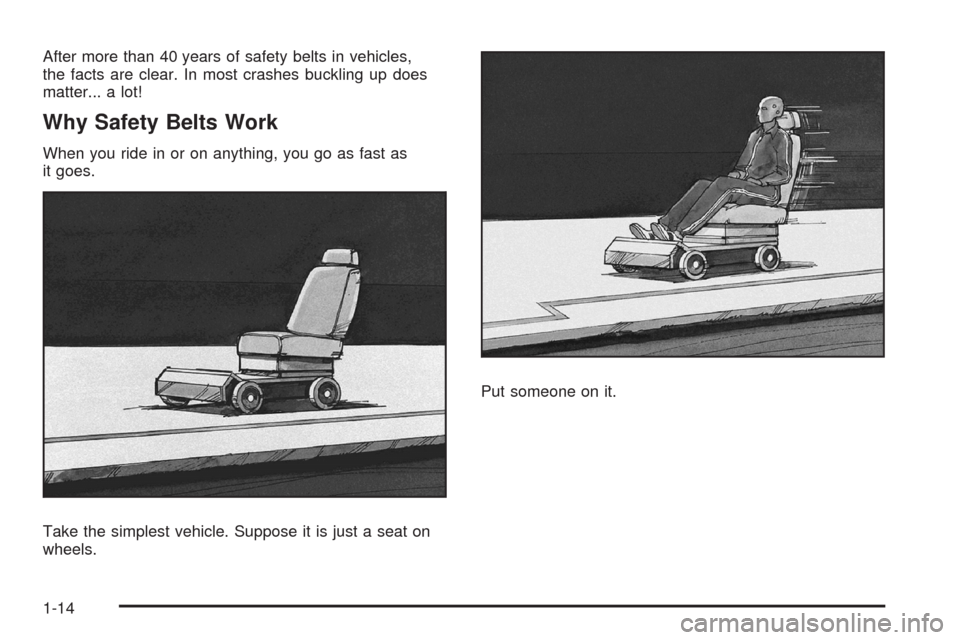
After more than 40 years of safety belts in vehicles,
the facts are clear. In most crashes buckling up does
matter... a lot!
Why Safety Belts Work
When you ride in or on anything, you go as fast as
it goes.
Take the simplest vehicle. Suppose it is just a seat on
wheels.Put someone on it.
1-14
Page 19 of 448

Get it up to speed. Then stop the vehicle. The rider
does not stop.The person keeps going until stopped by something.
In a real vehicle, it could be the windshield...
1-15
Page 20 of 448

or the instrument panel... or the safety belts!
With safety belts, you slow down as the vehicle does.
You get more time to stop. You stop over more distance,
and your strongest bones take the forces. That is why
safety belts make such good sense.
1-16